IDEX Online Research: Jewelry Price Inflation Still Running At High Levels
November 23, 08
The Fed may now be worried about deflation, but price inflation is still very real in the jewelry industry. Both the Jewelry Consumer Price Index (JCPI) and the Jewelry Producer Price Index (JPPI) rose significantly in October.
Here’s the summary of inflation at the jewelry retail and supplier level for the month of October, as expressed as a percentage change year-over-year (October 2008 versus October 2007):
- Jewelry Producer Price Index +4.9%
- Jewelry & Watch Consumer Price Index +7.5%
- Jewelry CPI +8.2%
- Watch CPI +2.6%
While the rate of inflation has moderated somewhat, inflation continues to run well above historic levels at both the consumer and producer level in the jewelry industry.
In part, continuing above average inflation appears to be a surprise. Precious metals prices have moderated, some significantly. Diamond prices have been declining over the past couple of months.
So, why are retail and wholesale prices still very high, on a year-to-year comparison? There are two key reasons, in our opinion.
- In part, jewelers’ slow inventory turns are responsible. U.S. jewelers typically turn their inventory about one time per year; it is reasonable to assume that they are selling merchandise that they bought over the past year or so. Thus, when they bought gold, silver, platinum and diamond inventory, prices were at their peak, as the graph below illustrates.
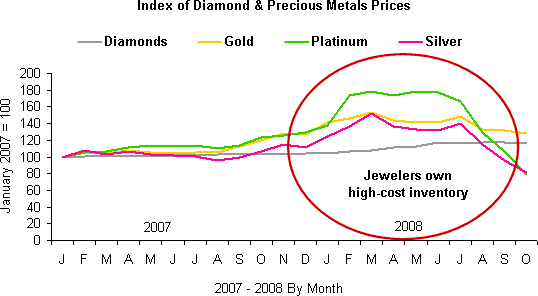
Source: Markets
Gold jewelry represents about 8 percent of a typical jeweler’s sales, and diamonds and diamond jewelry represent about 52 percent of a typical jeweler’s sales, according to the most recent data from the Jewelers of America. Platinum and silver are less important; together, they represent less than 3 percent of a typical jeweler’s sales.
Because jewelers purchased goods when commodity prices were at their peak, they paid a premium for the merchandise. Thus, they are still passing along their higher-cost goods, even though the prices of those commodities have fallen substantially.
- A second reason for continuing high retail and supply level prices is that jewelers and their suppliers have been trying to regain margins that were lost over the past few years. With lots of publicity about high inflation, many merchants have taken the opportunity to raise prices by riding on the coat-tails of higher overall inflation.
The question now is very different: with increased prospects for deflation, can we expect jewelry prices to fall, remain about the same or continue to rise, though perhaps at a slower pace? For the ten-year period between 1996 and 2005, retail jewelry prices fell in the U.S. each year by just a percent or two. Inflation reared its head only in the past three years.
As the Federal Reserve tells the financial community, some inflation is healthy. Our sense is that price inflation at an annual rate of +2-3 percent is probably healthy for the jewelry industry. Persistent deflation is not good, nor is raging inflation.
In the end, consumers will help answer that question. If jewelry seems like a value – either through price-based promotions or via some other marketing vehicle, then shoppers will buy jewelry which is priced reasonably. If, however, consumers perceive that jewelry is not a value at current prices, retailers will be forced to reduce prices.
Our Outlook
Earlier this year, we said that we did not believe that price inflation could continue at high single digit levels. For the year-to-date, retail jewelry prices are up 6.9 percent while jewelry producer prices are up 7.3 percent. We made our forecast based declining precious metals prices late this summer; precious metals prices have been the primary driver of jewelry price inflation.
It now appears that jewelry price inflation is headed lower; we have seen the largest price increases of the year during the first half of 2008, though there could be some inflation volatility for short periods over the next couple of months as the market settles down and finds stability.
We continue to forecast both jewelry CPI and jewelry PPI to be about +7 percent for the full year of 2008, though the final two months of the year are important, since the typical U.S. jeweler generates almost one-third of their annual sales in this two-month period. Whatever happens, though, we believe that the worst inflationary environment is over.
Jewelry Producer Price Index (JPPI) +4.9 percent in October
U.S. jewelry producer prices (JPPI) rose by 4.9 percent in October 2008, according to the U.S. Bureau of Labor Statistics (BLS). This was one of the smallest monthly gains this year, and reflects retreating precious metals prices.
There is still a backlog of high-cost goods in the distribution pipeline that suppliers need to pass on to their customers. But the good news is that the pressure is off – suppliers’ costs have begun to moderate, so they aren’t being forced to continue to raise prices in the face of a weakening environment of consumer demand.
We believe that suppliers will likely hold off on any new price increases near term for two reasons: 1) jewelers simply won’t accept higher prices going into the holiday selling season; and 2) suppliers are “taking the temperature” of the current sales environment – if demand weakens, they will be much more reluctant to try to force their customers to accept higher prices for goods.
Because the supplier community is so fragmented, no one has pricing power. We’ve already seen some panic pricing by suppliers who are trying to move goods – at a loss, if necessary – to raise cash. In that kind of environment, any supplier who tries to raise prices will lose business.
For the year-to-date, jewelry supplier price inflation for jewelry in the U.S. market is running at an annual rate of +7.3 percent.
The following graph summarizes the monthly Jewelry Producer Price Index for inflation since the beginning of 2007. The percentage figures are based on year-to-year comparisons of the BLS Jewelry Producer Price Index.
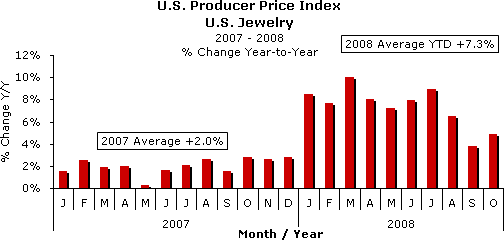
Source: BLS
What is fueling this decelerating pace in the Jewelry Producer Price Index? Prices for both precious metal jewelry and gemstone jewelry have moderated. The graph below compares the JPPI (red bars) to inflation for precious metals (gold bars); gold has been the primary driver of precious metals inflation, until October.
We note, further, that producer price inflation in October was below the retail price inflation rate for the entire jewelry category. Earlier this year, producer prices in the precious metals category rose more than the corresponding retail prices. Now, retail prices are catching up, though we continue to believe that retail jewelry price inflation will moderate in the fourth quarter. However, these trends illustrate the lag effect – 3-5 months – between rising producer prices and the resultant rising retail prices.
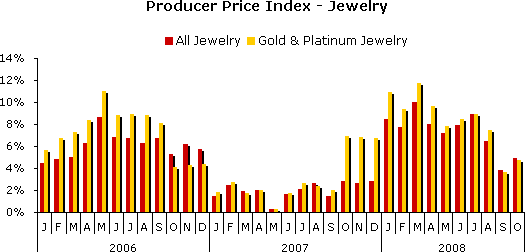
Source: BLS
Jewelry Consumer Price Index (JCPI) +7.5 percent in October
U.S. jewelry consumer prices (JCPI) rose by 7.5 percent in October, as calculated by the BLS. After rising sharply in March, April, and May, jewelry price increases at the retail level moderated in June, but re-accelerated in July and August. In September, there was a significant moderation in the jewelry retail inflation rate. In October, inflation picked up its pace. For the year-to-date, retail price inflation for jewelry in the U.S. market is running at an annual rate of +6.9 percent.
We believe that jewelry retail prices rose sharply early in the year as retailers re-priced goods to reflect the pent-up inflation that was flowing through from the supplier level. Zale, Sterling (Kay) and others announced they were going to raise prices. As a result, most independent specialty jewelers also implemented price increases.
We think that June’s retail price inflation pause was either a statistical aberration or a momentary pause in inflation. Either way, jewelers continued to raise their prices in the face of sharply rising costs, as shown by the July and August data. September’s inflation rate, while down from prior levels, is still high by historic trends. October’s inflation rate reflects market volatility more than any thing else, in our opinion.
The graph below summarizes the percentage change in retail prices of jewelry and watches by month on a year-to-year basis since 2007. The percentage change is based on a comparison to the same month a year ago (October 2008 versus October 2007).
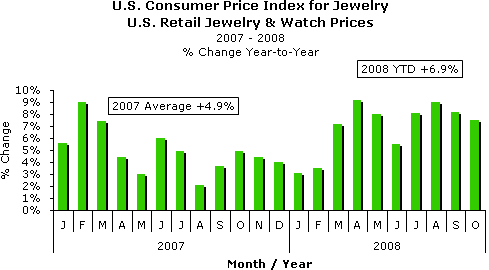
Source: BLS
Earlier this year, the components of jewelry and watch price inflation at the retail level reflected a dichotomy in price increases. Jewelry retail prices were up consistently during the first half of 2008, but watch retail prices showed virtually no price inflation. In the past few months, watch price inflation has suddenly increased.
In particular, watch prices spiked in October, when compared to the prior months. We are not surprised; the only surprise is that watch price inflation lagged so much early in the year. Why? There are two key reasons: 1) mechanical watch mechanisms from Switzerland have been in short supply due to manufacturing capacity constraints; and 2) demand for high-end watches and branded watches has been relatively strong, according to retail jewelers.
The graph below illustrates the JPPI consisting of both jewelry and watch prices (green bars), jewelry prices only (red bars), and watch prices (yellow bars).
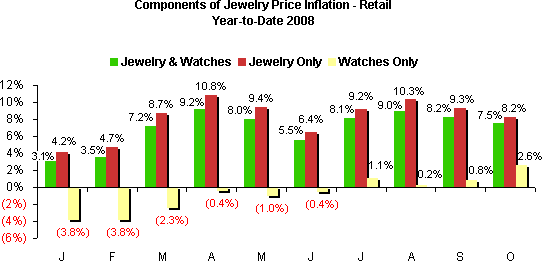
Source: BLS
Outlook: Inflation Will Moderate in the Fourth Quarter
Our forecast calls for both jewelry consumer prices and jewelry producer prices to rise by about 7 percent in 2008. We had thought that jewelry price inflation, both at the supplier and retail level might abate in the fourth quarter, but that does not appear to be happening. However, stay tuned, because this is an evolving situation.